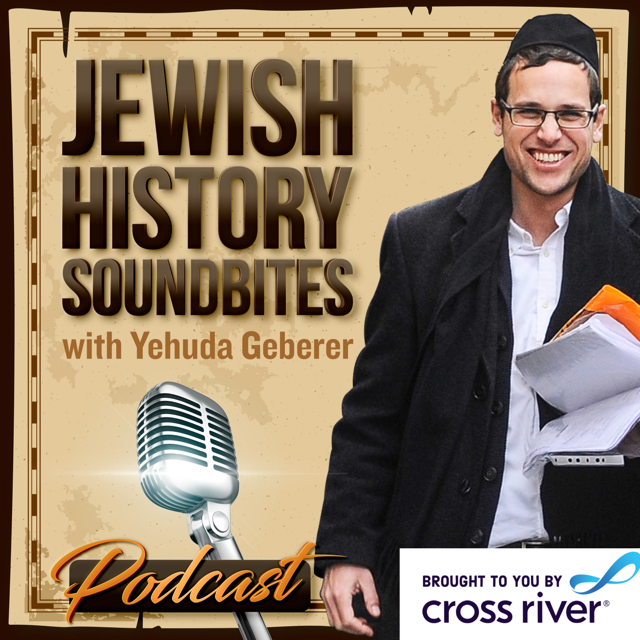
1.7M
Downloads
457
Episodes
Listen to noted Tour Guide, Lecturer and Yad Vashem Researcher of Jewish History Yehuda Geberer bring the world of pre-war Eastern Europe alive. Join in to meet the great personages, institutions and episodes of a riveting past. For speaking engagements or tours in Israel or Eastern Europe Yehuda@YehudaGeberer.com
Episodes

Tuesday Jul 05, 2022
Jewish Saviors of the Holocaust Part I: Monsieur & the Belgian Orphans
Tuesday Jul 05, 2022
Tuesday Jul 05, 2022
Jewish History Soundbites is proud to launch a special series entitled ‘Jewish Saviors of the Holocaust’. It will explore the narratives of Jews under Nazi occupation risking their lives to save others during the Holocaust. Each unique profile will explore another story, angle and individual (or group of individuals) who though their own lives were at risk still did everything in their power to save others.
The series opens with the story of Yona Tiefenbrunner, known to the orphans he saves as ‘Monsieur’. Born in Germany, he arrived as a refugee in Belgium shortly before the war’s outbreak. He initially opened an orphanage at his own expense in order to assist German Jewish refugee children. With the Nazi occupation of Belgium and the subsequent deportations in 1942, his Brussels orphanage emerged as an island of rescue, as the Nazis miraculously allowed the orphanage to operate and spare the children from deportation to the east. Maintaining a semblance of normalcy under increasingly challenging conditions, Yona managed to care for the orphans' physical and religious welfare until liberation. Following the war, the orphanage relocated to Antwerp and cared for children survivors until its closing in 1960.
To dedicate an episode in the Jewish History Soundbites ‘Jewish Saviors of the Holocaust’ series, please contact Yehuda at yehuda@yehudageberer.com
For sponsorship opportunities about your favorite topics of Jewish history contact Yehuda at: yehuda@yehudageberer.com
Subscribe To Our Podcast on:
PodBean: https://jsoundbites.podbean.com/
Follow us on Twitter or Instagram at @Jsoundbites
You can email Yehuda at yehuda@yehudageberer.com
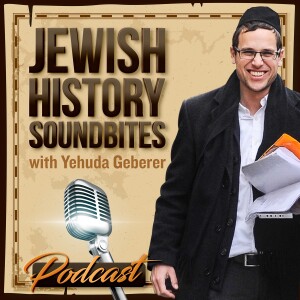
Monday Jun 27, 2022
An Enlightened Song: The Story of Shir
Monday Jun 27, 2022
Monday Jun 27, 2022
Prague has had its fair share of characters throughout its storied history, yet Shlomo Yehuda Rapoport (1790-1867) or Shir as he was known was definitely one of the more interesting ones. Born into a rabbinic family in Lvov, Shir married the daughter of Rav Aryeh Leib Heller, the author of the Ketzos Hachoshen. Though he remained a scholarly, observant and rabbinic Jew for the remainder of his life, he also associated with the emerging Galician Haskalah (Jewish Enlightenment) of his era.
His intellectual pursuits included the study of medieval Jewish philosophy, languages, general science, history and literature, while his social circles included the famous maskilim of Galicia. In an attempt to alleviate his financial struggles his friend Yosef Perl arranged for his appointment to the rabbinate of Tarnopol. Traditionalist opposition made the position unsustainable, and in 1840 he was appointed rabbi of Prague where he remained until his passing.
For sponsorship opportunities about your favorite topics of Jewish history contact Yehuda at: yehuda@yehudageberer.com
Subscribe To Our Podcast on:
PodBean: https://jsoundbites.podbean.com/
Follow us on Twitter or Instagram at @Jsoundbites
You can email Yehuda at yehuda@yehudageberer.com
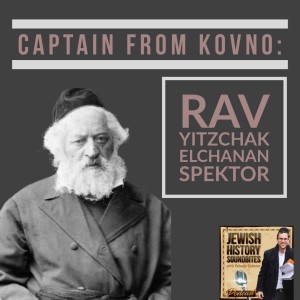
Sunday Jun 19, 2022
Captain from Kovno: Rav Yitzchak Elchanan Spektor
Sunday Jun 19, 2022
Sunday Jun 19, 2022
Perhaps the most acclaimed leader of Russian Jewry of the 19th century was Rav Yitzchak Elchanan Spektor (1817-1896). A long-time Rabbi of Kovno, his impact reached the far reaches of the Russian Empire and beyond. He served as the leading posek in all halachic matters, the arbiter of many disputes and lent his name to diverse causes such as the Kovno Persushim Kollel and Chovevei Zion. Exhibiting leadership on the burning issues of the day, he forged a relationship with the financial elite in St. Petersburg and with Czarist government officials lobbying on behalf of the general community.
For sponsorship opportunities about your favorite topics of Jewish history contact Yehuda at: yehuda@yehudageberer.com
Subscribe To Our Podcast on:
PodBean: https://jsoundbites.podbean.com/
Follow us on Twitter or Instagram at @Jsoundbites
You can email Yehuda at yehuda@yehudageberer.com
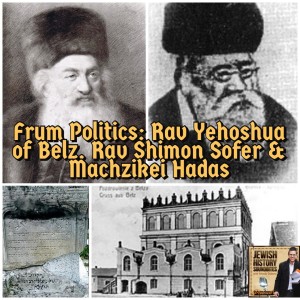
Sunday Jun 12, 2022
Frum Politics: Rav Yehoshua of Belz, Rav Shimon Sofer & Machzikei Hadas
Sunday Jun 12, 2022
Sunday Jun 12, 2022
Founded in 1879 the Rav Yehoshua of Belz and Rav Shimon Sofer, the Machzikei Hadas political party was the first Orthodox political party in Jewish history. The unique status of Galician Jewry of the 19th century, as a heavily traditional, demographically large community who had already received emancipation from the Habsburg monarchy in 1867, led the leaders of Orthodox Jewry there to utilize the benefits of emancipation to further the cause of traditional Jewry. Rav Shimon Sofer even got elected to the Austrian parliament.
The mouthpiece of the organization was a newspaper of the same name, and emerged as another modern tool to preserve tradition. Though its influence waned after an initial decade of success, this pioneering endeavor left a lasting impact on the developing environment of Orthodox politics.
For sponsorship opportunities about your favorite topics of Jewish history contact Yehuda at: yehuda@yehudageberer.com
Subscribe To Our Podcast on:
PodBean: https://jsoundbites.podbean.com/
Follow us on Twitter or Instagram at @Jsoundbites
You can email Yehuda at yehuda@yehudageberer.com
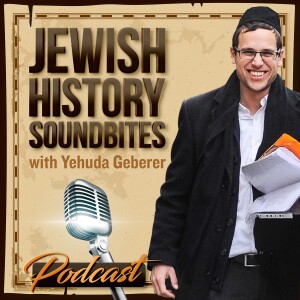
Friday Jun 03, 2022
Shavuos Musings & Uri Zohar Tribute
Friday Jun 03, 2022
Friday Jun 03, 2022
The recent passing of Uri Zohar is an opportunity to pay tribute to this unique individual who made the journey from the apex of the Israeli entertainment world to embracing religious observance.
With Shavuos approaching, it’s an opportunity to reflect on some of the historical events which are associated with this season throughout history. From the deportations of Hungarian Jewry in 1944, to liberation a year later, to the events of the First Crusade and the Khmelnytsky massacres of 1648-49, many tragic events somehow occurred around this time. The yahrzeits of both the the Baal Shem Tov and the Ger Rebbe the Imrei Emes are on Shavuos as well. These and several other curious events, are analyzed in these musings on Shavuos and Jewish History.
For sponsorship opportunities about your favorite topics of Jewish history contact Yehuda at: yehuda@yehudageberer.com
Subscribe To Our Podcast on:
PodBean: https://jsoundbites.podbean.com/
Follow us on Twitter or Instagram at @Jsoundbites
You can email Yehuda at yehuda@yehudageberer.com
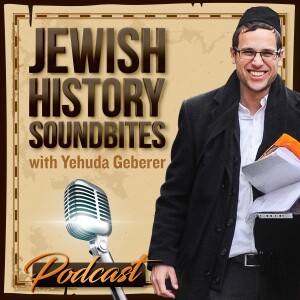
Sunday May 22, 2022
A Chassid in Krakow: The Maor Veshemesh
Sunday May 22, 2022
Sunday May 22, 2022
Rav Klonymous Kalman Halevi Epstein (1751-1823) is known by his posthumously published work the Maor Veshemesh. Born into a poor family, he spent the bulk of his childhood selling bagels in the streets of Krakow to support his family. He eventually emerged as a budding Torah scholar, and later joined the nascent Chassidic movement, becoming a close follower of the Noam Elimelech of Lizhensk.
He later attempted to establish a chassidic presence in Krakow, but faced much opposition from the establishment. Eventually returning to his home town of Neustadt, he gained a following, while he himself continued to travel to the great tzadikim of his day. His burial site in Krakow is much visited until this very day, while his primary legacy in the form of his sefer Maor Veshemesh is sometimes referred to as ‘the Shulchan Aruch of Chassidus’.
For sponsorship opportunities about your favorite topics of Jewish history contact Yehuda at: yehuda@yehudageberer.com
Subscribe To Our Podcast on:
PodBean: https://jsoundbites.podbean.com/
Follow us on Twitter or Instagram at @Jsoundbites
You can email Yehuda at yehuda@yehudageberer.com
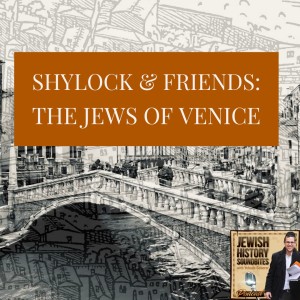
Monday May 16, 2022
Shylock & Friends: The Jews of Venice
Monday May 16, 2022
Monday May 16, 2022
Jews have lived in Venice for more than a millennium. In 1516 the Jewish community of Venice was restricted to one area of the city, and this came to be known as the Ghetto, the first of its kind in Europe. Jewish life flourished, and it became a pioneering center of the printing of Hebrew books, most famously in the printing press of the Christian Daniel Bomberg.
Though there were many famous Jewish personalities of Venice, including Don Yitzchak Abarbanel who lived out his last years in the city, the most famous Venetian Jew never even existed at all. Shylock is a fictional character and the primary antagonist in Shakespeare’s play The Merchant of Venice. While Shakespeare used - and to a certain extent created - anti-Semitic tropes which unfortunately were perpetuated by subsequent anti-Semites over the ensuing centuries, in many ways the character reflects the restricted reality of Venice’s Jews at the time.
For sponsorship opportunities about your favorite topics of Jewish history contact Yehuda at: yehuda@yehudageberer.com
Subscribe To Our Podcast on:
PodBean: https://jsoundbites.podbean.com/
Follow us on Twitter or Instagram at @Jsoundbites
You can email Yehuda at yehuda@yehudageberer.com
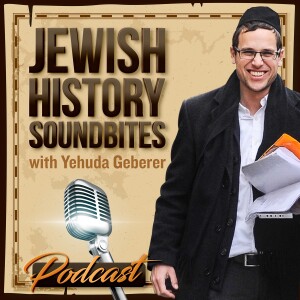
Saturday May 07, 2022
Hungarian Royalty: The Chasam Sofer & His Family
Saturday May 07, 2022
Saturday May 07, 2022
One of the most influential Torah leaders in the modern era was Rav Moshe Sofer, the Chasam Sofer (1762-1839). Rabbi, rosh yeshiva, posek, prolific author, and most of all, a charismatic leader who confronted the challenges of modernity, and led the forming of a traditional response in changing times.
A component of the legacy of the Chasam Sofer was his illustrious family, who emerged as something of a rabbinic dynasty in the ensuing generations. His son the Ksav Sofer succeeded him in Pressburg, while another son Rav Shimon Sofer was the rabbi of Krakow. Many of his descendants were rabbis all over the Austro-Hungarian Empire. Many either escaped or survived the war and continued his legacy in the rebuilding during the post war until this very day.
For sponsorship opportunities about your favorite topics of Jewish history contact Yehuda at: yehuda@yehudageberer.com
Subscribe To Our Podcast on:
PodBean: https://jsoundbites.podbean.com/
Follow us on Twitter or Instagram at @Jsoundbites
You can email Yehuda at yehuda@yehudageberer.com
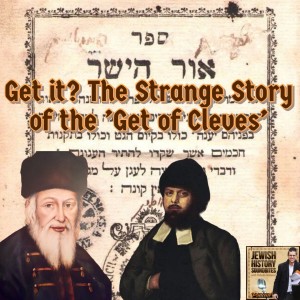
Monday May 02, 2022
Get it? The Strange Story of the ’Get of Cleves’
Monday May 02, 2022
Monday May 02, 2022
The strange story of the Get of Kleve (or Cleves) rocked the rabbinical world of the 1760’s. What commenced as an innocuous question regarding a young man’s mental faculties, and his resulting capability of participating in a divorce ceremony, soon exploded into a general dispute about a rabbinical courts sole jurisdiction over a halachic dispute and the imposing of majority opinion among rabbis.
While the Frankfurt rabbinical court maintained that the groom in question was insane and therefore the get which he delivered was invalid, an increasing number of rabbis across Europe agreed with Rav Yisrael Lifshitz regarding the validity of the get. Eventually Rav Yechezkel Landau of Prague, the Noda B'yehuda, entered the fray, insisting that the divorce document was valid. The dispute can be viewed within the larger context of events of Jewish society of the 18th century, with loosening control of the kahal and early signs of modernity causing instability within the circles of established authority.
This episode is sponsored by Legacy Judaica in honor of their upcoming auction, Sunday, May 8, 2022, 1:00 PM EST. The catalog is available here: https://bidspirit.com/r/3axy For a unique opportunity to purchase historical artifacts, books, letters of historical personalities and more, check out the Legacy Judaica auction.
For sponsorship opportunities about your favorite topics of Jewish history contact Yehuda at: yehuda@yehudageberer.com
Subscribe To Our Podcast on:
PodBean: https://jsoundbites.podbean.com/
Follow us on Twitter or Instagram at @Jsoundbites
You can email Yehuda at yehuda@yehudageberer.com
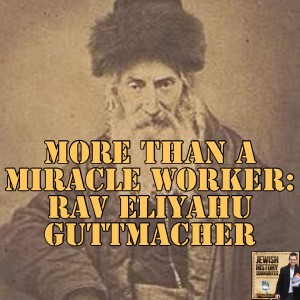
Monday Apr 25, 2022
More than a Miracle Worker: Rav Eliyahu Guttmacher
Monday Apr 25, 2022
Monday Apr 25, 2022
Rav Eliyahu Guttmacher (1796-1874) was a German rabbi who gained renown as a miracle worker during his tenure in the rabbinate of Gratz (Greiditz). Thousands from Poland and all over Europe would petition him asking for his blessings and prayers on every conceivable issue. A student of Rav Akiva Eiger, he was also a Kabbalist, and later a proto Zionist and supporter of the ideas of his colleague Rav Tzvi Hirsh Kalisher.
In 1932 a large cache of kvittelech sent to Rav Guttmacher was discovered. An analysis of this rare collection yields much information on the social, economic and religious life of Polish Jewry during the 19th century.
For sponsorship opportunities about your favorite topics of Jewish history contact Yehuda at: yehuda@yehudageberer.com
Subscribe To Our Podcast on:
PodBean: https://jsoundbites.podbean.com/
Follow us on Twitter or Instagram at @Jsoundbites
You can email Yehuda at yehuda@yehudageberer.com
